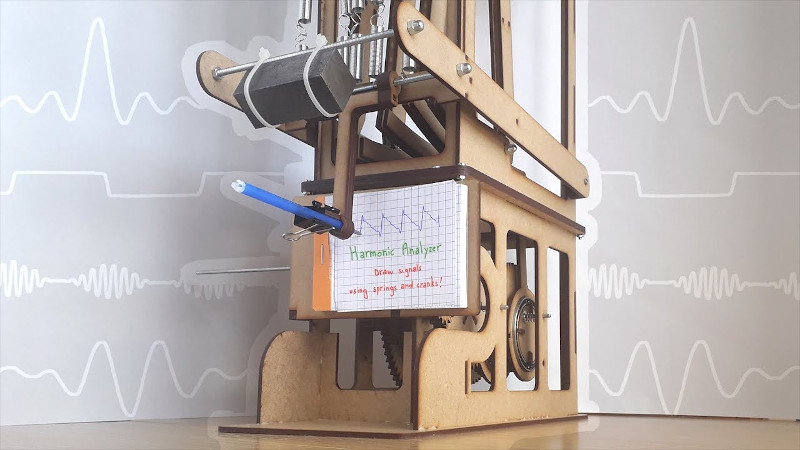Before graphic calculators and microcomputers, plotting functions were generally achieved by hand. However, there were mechanical graphing tools, too. With the help of a laser cutter, it’s even possible to make your own!
The build in question is nicknamed the Harmonic Analyzer. It can be used to draw functions created by adding sine waves, a la the Fourier series. While a true Fourier series is the sum of an infinite number of sine waves, this mechanical contraption settles on just 5.
This is achieved through the use of a crank driving a series of gears. The x-axis gearing pans the notepad from left to right. The function gearing has a series of gears for each of the 5 sinewaves, which work with levers to set the magnitude of the coefficients for each component of the function. These levers are then hooked up to a spring system, which adds the outputs of each sine wave together. This spring adder then controls the y-axis motion of the pen, which draws the function on paper.
It’s a great example of the capabilities of mechanical computing, even if it’s unlikely to ever run Quake. Other DIY mechanical computers we’ve seen include the Digi-Comp I and a wildly complex Differential Analyzer. Video after the break.
















Not to detract from this splendid achievement, but if this interests you then you would also want to see the professional-grade harmonic analyser that’s documented on YouTube:
https://www.youtube.com/watch?v=NAsM30MAHLg&list=PL0INsTTU1k2UYO9Mck-i5HNqGNW5AeEwq
tl;dr much?
Link to Bill Hammack’s video series on page 3 of the Instructable.
They even put the original inventors name and picture in the video in the article along with Bill who so elegantly presented it..
https://youtu.be/rgSNV5kMBoQ?t=17
I think they did their due diligence.
But. I agree the Engineer Guy videos really excellent and worth the time to enjoy.
My favorite is the candle lecture. It’s the kind of presentation that really inspires thinking deeply about the world around you.
https://www.youtube.com/watch?v=RrHnLXMTOWM
Next version should use a split nut on the drawboard carrier, so you don’t need to rewind the drive mechanism every time.
Then add a proper crank handle to it.
Great job of explaining how it works – takes it from being a toy to a teaching tool.
Cool, now I gotta figure out how to make a version that spins fast enough to drive a diaphragm and be an analog synth. Or of course steam power the whole thing and drive the valve on an auxettophone to bring 80s synthpop to steampunk. Then probably it would turn out as huge as a BSJ and need the right kind of orangutan to play it.